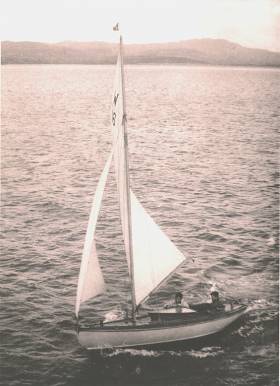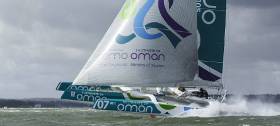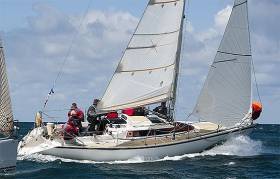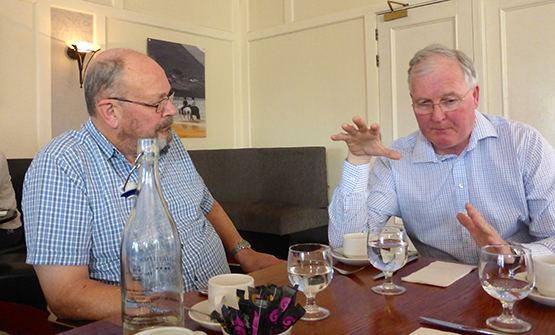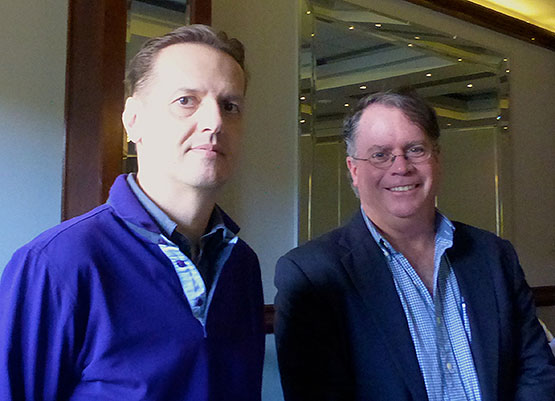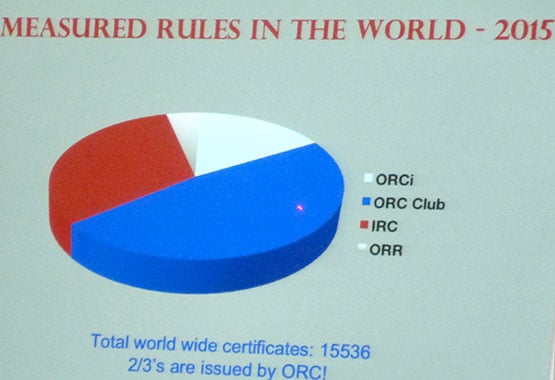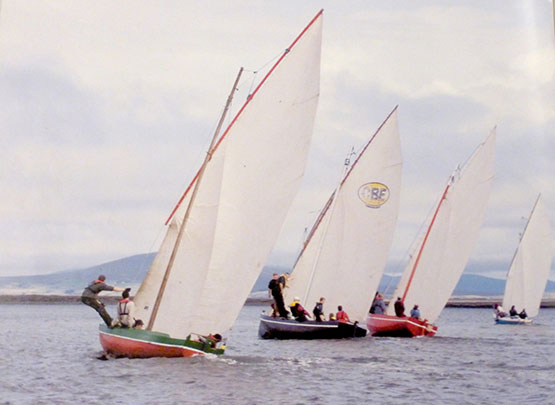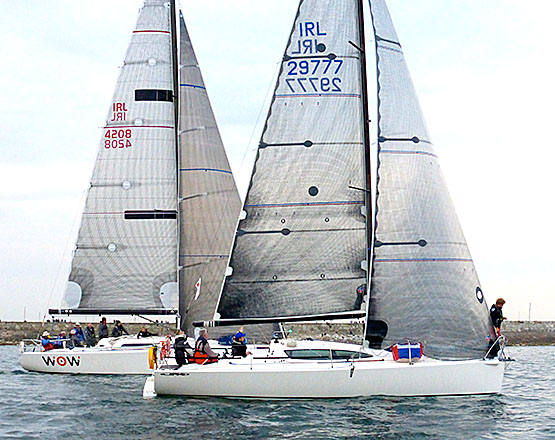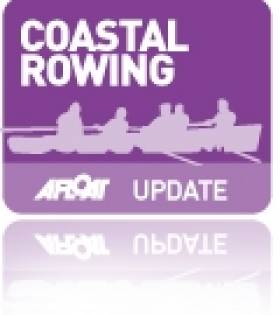Displaying items by tag: Round Ireland
Setting The Record Straight On Round Ireland Records
With May upon us, we’re into the season of Round Ireland record attempts in the smallest this or the widest that or the fastest other. So before anyone gets too excited, let’s put the record straight on “Small Boat Round Ireland Records” as they currently stand writes W M Nixon.
In 1961, the MacLaverty brothers of Belfast – Kevin and Colm, both alas no longer with us – sailed round Ireland in their 18ft 1948-built Belfast Lough Waverley Class bermudan-rigged keelboat sloop Durward, crewed by Mick Clarke who is now noted, among his many other distinctions, as the historian of Lough Erne Yacht Club. And if you want to go round in a smaller keelboat, you’ll have to do some research – even the Squibs are 19ft long, while Flying Fifteens are 20ft LOA.
Then in 1976, James Cahill of County Mayo sailed round Ireland with a crew in a 13ft 6ins open clinker–built sailing dinghy.
But in 1990, Rob Henshall – now of Fermanagh, but originally of Cultra, County Down – raised the bar when he sailed round Ireland in a Laser alone, and unaccompanied by any support boat or shore team.
And in 1992, Rob Henshall went round alone again, still unaccompanied, and this time on a slightly overladen Bic windsurfer.
All these record makers attended the Cork Dry Gin Round Ireland Records Gala Dinner in the National Yacht Club in November 1993 to celebrate the remarkable new Round Ireland speed record set in September 1993 by Steve Fossett and his crew on Lakota, including Con Murphy and Cathy McAleavey of the NYC, a record which stood until a year ago, when it was bested by Sidney Gavignet in the MOD 70 trimaran Omansail. And at that epic dinner, all the small boat sailors – loners or otherwise – proved every bit as sociable as the people off the glamorous big speed machines.
First ISORA Coastal Yacht Race Goes to J/109 Ruth (UPDATED)
Defending ISORA champion Ruth (Liam Shanahan) from the National Yacht Club was the winner of yesterday's first coastal IRC handicap race of the season but not before a protest for redress was lodged following a finish line problem off Wicklow writes Peter Ryan. Full results are downloadable below.
In a buoyant turnout, 20 boats departed Dun Laoghaire harbour on a 29–nautical mile course for Wicklow.
The J/109 champion made the best of a very light wind start from Dun Laoghaire's Pier Mark as a mixed fleet of cruiser types jostled for a clear lane on a shy spinnaker reach out of Dublin Bay

Spinnakers flying – but only just – part of the 20–boat ISORA fleet depart Dun Laoghaire yesterday morning bound for Wicklow. To windward Chris Power–Smith's J122 Aurelia (IRL 35950), the First 40.7 Tsunami (IRL4007) Vincent Farrell and Darragh Cafferkey's A35 Another Adventure.
The first race of the Overall ISORA Avery Crest Offshore Championship 2016 was also the first race in the ISORA Viking Marine Coastal Series 2016 and the Royal Alfred Yacht Club Coastal Series 2016. The weather for the race was like “champagne sailing” except a few degrees colder.
This first race saw the appearance of some new boats to ISORA. Kuba Szymanski’s “Poilshed 2”, Grant Kinsman’s “Thalia”, Daragh Cafferky’s “Another Adventure” and Stephen Mullarney’s “Applegreen Sail for Kids” all took part in this race. Carol Bellamy’s “ Pink Panther” returned to the ISORA fleet after a few years sabbatical.
20 boats took part in the race and another 6 boats took part in the ISORA day race being run from Pwllheli at the same time. This gave a record 27 boats racing in ISORA!
It had been hoped that the course would be to start in Dun Laoghaire, round North Arklow and finish in Wicklow. However, the forecast on the day was for lighter northerly winds than originally thought making the beat from North Arklow to Wicklow impossible against the very strong south going tides.
The Race Committee changed the course shortly before the start to: Start in Dun laoghaire – South Burford (S) – North India (S) – South India (S) and Finish in Wicklow.
As forecast, the winds at the start were light northerly as NYC Commodore, Larry Power, sent the fleet of 20 boats reaching off towards the first mark. Fluky winds and conditions at the start made it difficult for many of the boats to get fast off the start line. Chris power-Smith’s “Aurleia”, Peter Hall’s “Adelie” and reigning ISORA Champion, Liam Shanahan’s “Ruth” were the first boats to break away. Aurelia took a northerly course, Adelie headed south and Ruth took a mid course.
Shortly after rounding the first mark, the boats headed in a run down towards the India Bank against the last of the north going tide. Although the fleet were well spread, there was little change in positions with “Ruth” leading the fleet from the centre. “Aurelia” went far out to sea while “Adelie” gybed in towards the coast. When the fleets merged at North India, the tide had turned and was flowing south at 3.5 knots. The placings remained largely unchanged with again “Ruth” leading the fleet.
John Keogh’s “Windshift” and Byran Dobson’s “Obsession” misjudged the rounding at North India and got swept around the wrong side of the mark. The light winds were not sufficient to propel both boats back to the North India due to the strong tide and they had to retire.
The third leg was the short blast down along the India Bank before the fleet hardened up for the dash to Wicklow. Those boats with asymmetric spinnakers gained hugely on this leg as they were able to hold reaching kites while the other were forced back to white sails and fell behind.
Due to a technical problem at the original finish line, the finisher in Wicklow had to change the line just as “Ruth” was approaching. This led to “Ruth” seeking redress.
“Ruth” took line honours, winning Overall and Class 1. “Adelie” came 2nd Overall and 1st in Class 2. David Simpson’s “Albeiro” took Silver Class.
As the boats finished most made their way into Wicklow harbour for the usual ISORA après sail get together at WSC. There pleasantries were exchanged between crews and tips and comments were freely exchanged. Crews gathered in the sunshine outside the club and planned their next ISORA adventure.
As the race was tracked using the Avery Crest Trackers, the progress of the race can be re-played using the YB app or on the ISORA website
With eight weeks to go to the Round Ireland Race from Wicklow, many in the Irish Sea offshore fleet are using the early ISORA races as a valuable tune–up with yesterday's first race providing many of the conditions that will be experienced in June.
The next race is the first offshore on the 14th May from Dun Laoghaire to Holyhead. It is hoped that there will be another large fleet taking part in preparation of the Round Ireland race in June.
Foxall Signs Up for Round Ireland Race on Mod 70 OmanSail
Ireland's top offshore sailor Damian Foxall, a Round the World Race winner, will compete in June's 2016 Volvo Round Ireland (VRI) Race from Wicklow. Kerryman Foxall will race on the MOD 70 Musandam – OmanSail, one of two of the fastest multihulls in the world to enter the Irish classic.
Ned Collier-Wakefield will bring the second MOD 70, Concise 10, to Wicklow having picked up his weight in rum as the prize for winning the Grand Prix Multihull event. Wakefield alos smashed the all-time course record in the Mount Gay Rum Round Barbados Race in March.
Musandam – OmanSail holds the record for a circumnavigation of the island of Ireland under sail, achieved in May of last year and the team are looking forward to beating this record in a race setting. The Omani team in 2016 will be much the same as last year, under skipper Sidney Gavignet.
The official race record for a monohull is held by Mike Slade who completed the race in 2 days 17 hours 48 minutes 47 seconds in ICAP Leopard 3 in 2008.
This record was under threat once George David signalled his intention to enter Rambler 88 in the 2016 VRI race. Rambler was first monohull home in last November's Rolex Middle Sea Race 2015.
INSS DBSC Spring Chicken Winners Are Round Ireland Lynx Crew
The Team INSS win in last weekend's 46–boat Dublin Bay Sailing Club Spring Chicken Series represented much more than just a win as it represented an important milestone in an offshore racing campaign. Look closer at the INSS 1720 crew and you will see that it was largely made up of those that will race onboard LYNX, the Reflex 38 owned by the INSS, which is giving five people the chance to race Round Ireland on a thoroughbred race boat.
Kenny Rumball, who skippered the 1720, and will skipper LYNX this June, elected to use the DBSC Spring Series as training for the Round Ireland Campaign. Now that the experienced crew are in shape for the season, INSS thoughts are turning to bringing the whole crew together.
The LYNX yacht itself has undergone a few changes ahead of this year’s race and the first training weekend for the crew is coming up on the 16th & 17th of April. Four of the five slots have been filled and there is still one spot up for grabs for a budding offshore racer who wants to compete in the Round Ireland and learn, all while being part of an experienced offshore racing crew.
With an intensive training programme coming up, including two training weekends and four ISORA races including deliveries, the crew should be well honed prior to the start of the campaign. There’s more details on the Round Ireland Campaign on Lynx available here.
The Irish Cruiser-Racer Association (ICRA) is a unique organisation. “Run by sailors for sailors”, it is nevertheless a very land-centric administrative body whose only manifestation afloat as a group with its own identity is seen at the organisation of the annual ICRA Nationals. And the sense of it relating purely to the island of Ireland is accentuated by the fact that much of its work is essentially back-office activity, dealing with handicaps and all the other paraphernalia involved in providing the nation’s numerous and very diverse cruiser-racer fleet with meaningful racing. W M Nixon went to last Saturday’s ICRA Conference to get a flavour of what ICRA does, and came away both impressed and stimulated.
Sweeping along southwestward towards Limerick on our wonderful motorway system, while one’s body stays firmly on the dual carriageway, the mind can wander into any pathways it wishes. So we got to thinking that, in this age of increasing numbers of administrators trained to third level degrees in the running of not-for-profit organisations, it’s a bit odd to find a very successfully central organisation which is apparently run – and well run at that - on a Corinthian basis “by sailors for sailors”.
Surely in today’s climate, which favours key bodies such as this being run by highly-trained specialists on at least a semi-professional basis, a seemingly amorphous organisation which is “run by sailors for sailors” is verging on a clear case of the asylum being taken over by the lunatics?
We’d soon see. Meanwhile, why on earth hold an annual conference in Limerick? With Ireland’s population distribution changing so rapidly, skewing both towards the large urban centres and particularly towards the east coast and Dublin, surely anyone organising a national conference would find it attendee-friendly to look at the latest map of population weighting. As it happens, I’m not sure that such a map exists, but we’d like to think that with today’s computers it is possible to construct a map where, after due calculation, you could pinpoint to the exact centre of Ireland’s total population distribution.
So you set out heading for Limerick at an unfeasibly early hour thinking that maybe a central location such as pretty Portlaoise or tidy Trim would probably be Ireland’s central point in relation to population distribution. But after some smooth time on the road with the sense of the wonderful west coast coming ever nearer, you begin to wonder why ICRA didn’t make a proper job of it, and take us to Dingle where we can breathe that wonderful Atlantic air and think great thoughts of sailing the high seas.

Far from the pressures of the cities of the east and south coasts, Dis-a-Ray is moored in the peaceful surroundings of Tarbert, where the south shore of the Shannon Estuary has already become part of the Kingdom of Kerry. Photo: W M Nixon
As it is, though the Dubs may think of Limerick as being on the western seaboard, it’s actually remarkably central when you draw lines across Ireland between all the best sailing locations. And as we knew that the position of Commodore of ICRA was going to pass on Saturday from Nobby Reilly of Howth (the Dingle of the East Coast) to Simon McGibney, Limerick was just about spot on in terms of equal travel time. For although the new Commodore has Foynes YC on the Shannon Estuary as his home club, his Dehler 101 Dis-a-ray is actually moored at his home at Tarbert which is further west down the Estuary, so much so that Tarbert is in the Kingdom of Kerry.
We arrived in to find a virtually full house distributed around a room-circling table such as they use for international diplomatic conferences to make peace with rogue states, with the layout being planned so that everyone can be an equal participant. It was grand for those of us who had arrived in the nick of time to get a seat, as we’d the fully-equipped table in front of us (did anybody else find it the devil’s own job to open the rather good but tightly-wrapped little sucky sweets which are essential to a talking shop?), but being Ireland several people arrived late, the show was already on the road, and they’d to find a seat as best they could.
All of which meant that there was a bigger turnout than expected, which is good news for ICRA. And for those of us comfortably ensconced, it made for a fascinating throughput of information by a long list of speakers, even though the layout meant that networking was restricted to the one hour lunch break if - like many people - you were relying on the 3.30-3.45pm wrap-up to facilitate returning to Dublin or Cork or wherever for a completely different event that night.
From the beginning, the dominant theme was on how we get more people into sailing, and everyone blithely talked as though we’re offering Joe Public a warm and sunny Croatian sailing product right here in Ireland, cheerfully ignoring the fact the last two summers have been plain lousy in terms of good weather.
Certainly the sailing was great for the enthusiast, but can you imagine a newcomer to the rough and ready sailing world wondering where on earth the attraction of it all was to be found as they were blown and bashed around at what we thought of as the utterly wonderful ICRA Nationals at Kinsale in June, or took in the all-too-typical variety of Irish summer weather at the hugely successful Volvo Dun Laoghaire Regatta in Dublin Bay in July?
Yet there is a fresh demand out there, and two of the morning’s speakers, Alistair Rumball of the Irish National Sailing School in Dun Laoghaire and Des McWilliam of McWilliam Sailmakers in Crosshaven, gave excellent talks on encouraging it, with Alistair showing us how his programme of moving beginners through dinghies and on into the school/club’s1720s, then became an inevitable progression into gaining experience and instruction on the school’s Prima 38 Lynx.
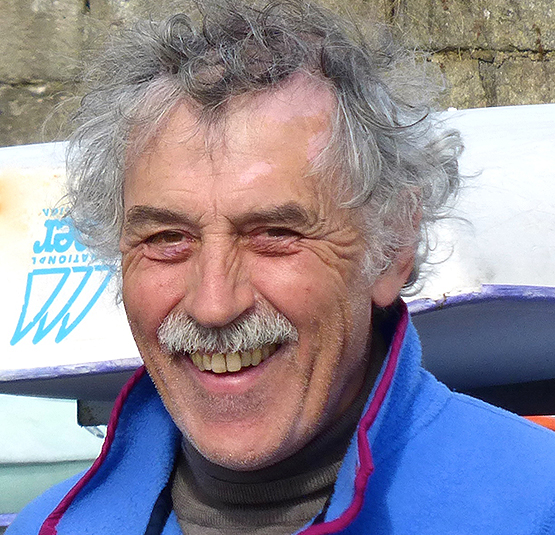 The mover and shaker. Alistair Rumball’s Irish National Sailing School in Dun Laoghaire is first port of call for many newcomers to sailing. Photo: W M Nixon
The mover and shaker. Alistair Rumball’s Irish National Sailing School in Dun Laoghaire is first port of call for many newcomers to sailing. Photo: W M Nixon
“Lynx has been a greater success than we could have ever dreamed of” he said. “She has been so booked out with people keen to learn about sailing a cruiser-racer that we haven’t been able to get as much actual racing with ISORA and so forth as we’d like. But for 2016, she’s being taken out of our Dun Laoghaire setup for long enough to be organised for a proper shot at the Volvo Round Ireland”.
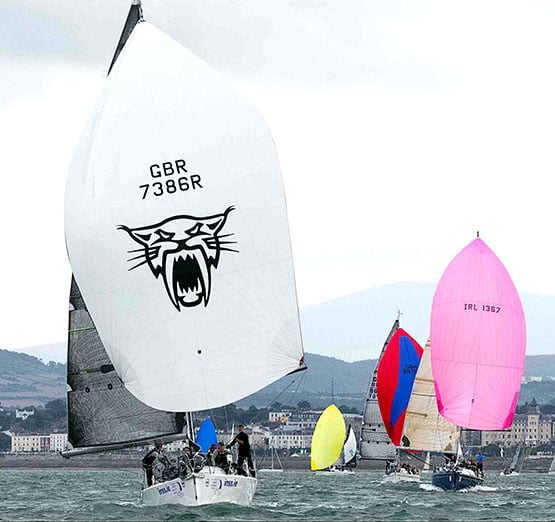
The double life of a Prima 38. The INSS’s Lynx in full racing mode in Dublin Bay (above), while below she is seen in early training mode as she takes a crew of beginners in cruiser-racing out for some formative experiences

As of last weekend in Limerick, there were just two crew places left aboard Lynx for this year’s Volvo Round Ireland on June 18th, and they’ve probably been snapped up by now. But the Rumball presentation underlined the fact that there are people out there who are mad keen to get into cruiser-racing, and it was up to ICRA to guide its members as to how best to tap into these wannabee sailors, instead of bleating all the time about how hard it is to find crew.
Des McWilliam leapt into the same theme, and gave us a crash course in how to make crewing on your boat more attractive to strangers. Admittedly the experience of seven years of acute economic recession have understandably made those who have kept boats in racing commission more than a little stressed. But if they want to reap the benefits of having struggled to stay in the boat-owning stream, then they have to make their cruiser-racers pleasanter to sail on, and more effective racing machines.
The McWilliam message was blunt in the extreme. “As a sailmaker in Ireland, each year I will race actively at many venues on upwards of 40 boats, both evenings and weekends. I will experience many different management and sailing styles. At the end of the year looking back, I usually realise that there might be only ten to a dozen boats out of that total of forty to which I would gladly and freely return for the good sport, the efficient sailing, the successful racing, the camaraderie – the fun. The rest of them are just work, involving duty visits. Please remember this when you are setting up the running of your boat, and trying to encourage people to sail with you.”
Des McWilliam of Crosshaven and Rory Staunton of Mayo. Des provided the meeting with some telling home truths about how attractive (or not) cruiser-racers throughout Ireland can be to sail on, while Rory Staunton led the charge in wondering why ORC and IRC cannot be amalgamated, and then went on to outline a new trailerable 33-footer he and an international group of friends are developing to make the incomparable west of Ireland a more accessible sailing area
We earned our lunch by going through an intensive session with Dobbs Davis of the Offshore Racing Congress, who had come to the conference with Zoran Grubisa to promote their measurement rule, which is used worldwide anywhere that IRC is not dominant, and in some key events such as the Rolex Sydney-Hobart Race, they are used in tandem, though IRC is currently the more-used system in that classic event.
It says everything about how Irish sailing punches way above its weight that these two guys thought it worth their while to come among us and evangelise for their system in a country which has a more-than-friendly relationship with the IRC and the people who run it. But it was fascinating stuff, making an input which added real spice to the day.
Davis is Chairman of the ORC’s Promotion & Development Committee, while Grubisa heads the Rating Officers Committee, and they run a system which is now the ISAF-approved rating method for the ISAF Offshore Worlds, which this year will be staged in Copenhagen in July, which as it happens is more or less the same time as the Royal Cork YC will be staging the new European IRC Championship in Volvo Cork Week at Crosshaven.
So the presence of the evangelists from the ORC at the ICRA conference could have opened up a right can of worms, but fair play to Dobbs Davis, he gave such an enthusiastic and lucid explanation of the completely transparent way in which ORC function that, for the time being at least, one’s instinctive loyalty to IRC was suspended out of intellectual curiosity.
Leading Offshore Racing Congress officers Zoran Grubisa (left) and Dobbs Davis were in Limerick to evangelise for the ORC Rating system
While IRC still has one or two hidden elements – the “Black Box” factor – with the transparency of ORC, you can always see how different inputs are effecting the final figure. One-design sailors may find all this utterly yawn-making, but as Davis pointed out, although there are so many successful cruiser-racer One-Design classes in America that ORC has yet to gain significant traction there despite being first set up in the US forty years ago, elsewhere in the world more and more people are coming to ORC as they enjoy watching boat innovation and performance analysis interacting to make their sailing more interesting and the results indicative of pure sailing ability.
The approachability of the ORC system was presented as one of its advantages
The slice of the cake worldwide for the different rating systems
But as we all know, where IRC and OCR are run side-by-side, despite the IRC’s hidden elements the two outcomes are often very similar. And in Ireland where we have a soft spot for the old S&3 34s which set world alight in 1969-73, the fact that the veteran though beautifully restored S&S 34 Quikpoint Azzura was overall winner of the Rolex-Sydney Hobart Race under OCR, after so nearly doing it on IRC, caused a bit of heart-searching. But nevertheless Rory Staunton from Mayo SC spoke for many when he demanded to know why IRC and ORC couldn’t get together and resolve their small differences for the general benefit of the offshore racing fraternity. Dobbs Davis said his door was always open, but that began to feel a bit too reminiscent of the current efforts to form a government, so we were glad enough to take a break for lunch and then return to the rating topic, but from an entirely different point of view
The inevitable expense in maximizing your boat’s performance potential under either IRC or ORC made the sheer economy of ICRA’s Progressive ECHO system seem immediately attractive, and the lead-in the afternoon session by SCORA Commodore Ronan Enright even more apposite. Because the fact is, you could run the Progressive ECHO Handicap System without even knowing what a boat looks like, let alone having her dimensions measured do the last millimtre.
Donal O’Sullivan of Dublin Bay SC, and Ronan Enright, Commodore SCORA, discussing sailing administration matters during the lunch break at Limerick. Enright went on to give an illuminating presentation about developments in Progressive ECHO Photo: W M Nixon
In the absence of ICRA’s ECHO supremo Denis Kiely - unavoidably absent for family reasons – Ronan Enright gave a quietly telling performance. It’s fascinating that though ECHO started life as the East Coast Handicap Organisation back around 1971-72, it’s now a nationwide service overseen by ICRA, and its most active area of development is in the cauldron of concentrated cruiser-racing which you find when the activities of Cork Habour and Kinsale are combined.
Basically, Progressive ECHO depends on the results of the most recent race, after which, if certain criteria have been fulfilled, the results are automatically re-computed to give boats a new rating based the supposition that they had all finished dead level on handicapped time. My own most recent experience of racing with it when it is being enthusiastically applied was in the Volvo Dun Laoghaire Regatta, which was a perfect test-bed for the system, as it was a compact series with the same fleet throughout.
The result is a series-long level of commitment by boats and crews who, under a more brutal system, would have seen their interest and enthusiasm flag after Day Two or even earlier. So really the message is: If we’re trying to get people to enjoy sailing and particularly to enjoy racing which is what the non-involved most easily comprehend, then Progressive ECHO is doing more to get bums on boats than anything else in Irish sailing, for believe me you have never seen anything quite so heart-warming as the response of a crew who, under One-Design or fixed handicap systems, had not been at the races at all, yet suddenly under Progressive ECHO they find they’ve recorded a win.
Which was all good news but perhaps the most interesting revelation of all from Ronan Enright was that the top IRC racers around Cork are now taking a closer interest in their Progressive ECHO showing than there are in their IRC results. For under IRC, they know they’ll be in the top six, but each post-race adjustment of Progressive ECHO gives them a very clear message about just how well or not they were really doing on the day.
Tom MacSweeney of this parish then hosted a forum which basically came down to how sailing can present a more friendly and accessible response to people who might be vaguely interested, and could be potential sailing enthusiasts. This involved him drawing on his training as a critical journalist, for as he admitted, when he first turned up with his first sailing boat – a Ruffian 23 – in Crosshaven, everyone from Denis Doyle downwards immediately made him welcome. But we can all think of non-assertive characters who are great sailors, yet if they hadn’t been in sailing families in the first place, they might not have taken up the sport at all owing to the sometime apparently closed nature of “yachting”.
We learned that very little of an Achill yawl is showing above the water after she capsizes. This is how they look in proper order
Allied to Des McWilliam’s incisive look at boats which you like to be aboard, and boats which you definitely don’t, and it all provided food for thought, as too did John Leech of Irish Water Safety with his no-nonsense presentation about a mature approach both to safety, and to being rescued. In an interesting mix of images, he showed us a photo of what happens to an Achill yawl when it capsizes. The result is an awful lot of rather waterlogged traditional boat under the surface, and only a little bit showing with the crew perched on top. As Des McWilliam was probably the only other person present with any idea of what an Schill yawl in full health looks like, the least we can do here is show you a photo of them in good sailing order. Meanwhile, John Leech concluded by saying that when you call out the ASR helicopters, think rather of how you can prevent your mast – if it’s still standing – from interfering with the rescue. Don’t for heaven’s sake use up emotional energy thinking about how much it all costs. They’re on standby all the time, and you the taxpayer have paid for them in the first place.
We concluded with Rory Staunton seeking interest and opinions for the new 33ft trailerable One-Design. While we all hope to get down to Clew Bay to sail the prototype this summer, could I suggest that one of the most exciting projects on the Irish cruiser-racer horizon is WIORA Week 2017 in the Aran Islands. So when they’ve finally got around to fixing a date, maybe the promoters of the new 33-footers could arrange to have a flotilla of them in Kilronan in 2017 to give the class a rocket-assisted launching.
Meanwhile this year’s WIORA West Coast Championship is under the auspices of the Royal Western of Ireland Yacht Club at Kilrush from June 29th to July 2nd. There’s so much extraordinary history in being able to write that simple bit of information that I reckon we’ll have to give it a complete blog in the future.
As for the ICRA Nationals, they’re at Howth from June 10th to 12th with both IRC and Progressive ECHO being used, while Volvo Cork Week comes up in July after the Volvo Round Ireland race has been tidied away in late June.
Although last Saturday’s Limerick gathering was essentially a wide-ranging conference, it was also the changeover to the new Commodore, with Simon McGibney taking on the mantle from the energetic and enthusiastic Nobby Reilly whose own boat, the Mills 36 Crazy Horse, was seen in virtually every event, and looked like heading for the win in Class at the ICRA Nats in Kinsale last June until new big winds swept George Sisk’s WOW to the fore. During Nobby’s busy time in the top office, ICRA’s activities and its reach steadily expand, while thanks to the persuasive efforts of Anthony O’Leary, a Commodore’s Cup team was assembled which regained the trophy in 2014.
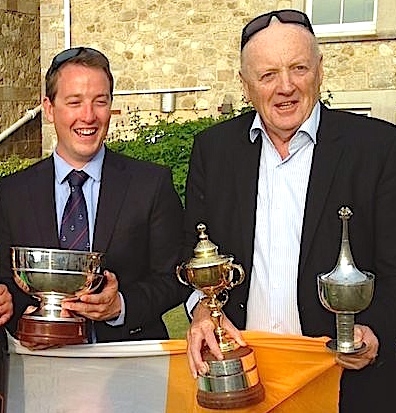 Ross MacDonald and ICRA Commodore Nobby Reilly at the Royal Yacht Squadron in Cowes in July 2014 after Ireland had won the Commodore’s Cup. At the ICRA Conference in Limerick last weekend, McDonald won a special award for his season’s results in 2015 with his X332 Equinox, while Nobby Reilly stood down after his successful years as Commodore, handing over the helm to Simon McGibney.
Ross MacDonald and ICRA Commodore Nobby Reilly at the Royal Yacht Squadron in Cowes in July 2014 after Ireland had won the Commodore’s Cup. At the ICRA Conference in Limerick last weekend, McDonald won a special award for his season’s results in 2015 with his X332 Equinox, while Nobby Reilly stood down after his successful years as Commodore, handing over the helm to Simon McGibney.
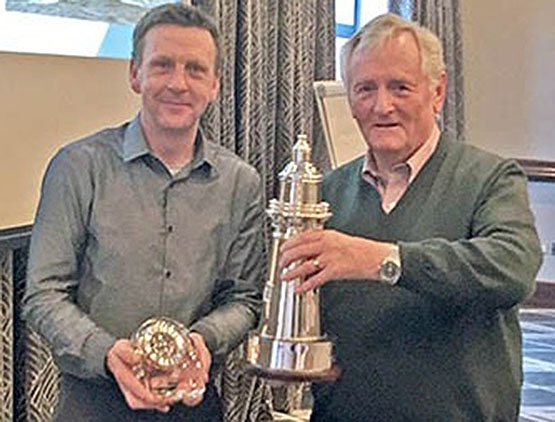
New ICRA Commodore Simom McGibney presents the “Boat of the Year” trophy to George Sisk of the Royal Irish Yacht Club, skipper of the Farr 42 WOW.
Work is going on behind the scenes to provide a strong defence this summer, but Anthony O’Leary wasn’t in Limerick to tell us about it, as he was away on his annual participation in America in the Viper 640 Championship, which just wouldn’t be the same if O’Leary wasn’t taking part - so much so that last year, he wasn’t present when his name came up as “Sailor of the Year” in Dublin, for he was away then too, Viper racing in the sun.
But other top sailors were there to round out the conference with the annual awards such as special performances by the likes of Dave Cullen with Checkmate XV and Ross Macdonald with Equinox and, while the ICRA Boat of the Year presentation, with warm acclamation, went to George Sisk of WOW, who not only admitted that his well-tested craft usually races with a crew of average age 53, but if he himself didn’t happen to be on board, the average age came down considerably………..And in case you think becoming ICRA Boat of the Year is all about glamour racing in sunshine, we close with a photo of WOW and the JPK 950 Alchimiste crawling towards the starting line for the Dun Laoghaire to Dingke race on the sort of damply windless evening that most folk would much prefer to spend comfortably at home.
It isn’t always glamour and warm sunshine and pleasant breezes. 2015 ICRA Boat of the Year WOW on a damp and windless evening approaching the start of the 280-mile Dun Laoghaire to Dingle race with the JPK 960 Alchimiste.
2016 Irish Sailing Preview: Busy Year For Busy People Ahead
Things are on the move again. There’s a buzz in the air. W M Nixon anticipates the sailing possibilities for 2016 in a fixtures list so diverse that he reckons that anyone who thinks they know everything that’s going on clearly doesn’t.
If you want anything done, then ask a busy man to do it. And the busier people are ashore, the keener they are to get afloat when they can. There was nothing more sluggish than the sailing and boating scene during the recession years. There was less zest for going sailing when you’d all the time in the world to do it because there was nothing to do ashore. And anyway, as a vehicle sport, sailing was a very identifiable expense which could be reduced or even discarded as the recession rumbled on.
Of course, it wasn’t as simple as that. Anyone with businesses to run knew they’d to keep a very close eye on things all the time if they were to survive at all. Thus we became experts at the short sailing break. The four day regatta became all the rage, and even if the good times roll again as never before, it seems likely the four day regatta is going to stay popular.
It’s indicative of amazingly changed times. Today, it’s beyond imagination to realise that at the height of Scotland’s industrial pomp around Glasgow for eighty years into the 1960s, there used to be a Clyde Fortnight. Two whole weeks of sailing on the trot. Except for Sundays of course, when the church services became yachting events. But even with that spiritual input, it was conspicuous consumption gone mad to be able to show you’d the resources and free time to go off yacht racing for a clear fortnight, knowing your employees – or rather, your inherited company’s employees – would keep those profits and dividends rolling in while you swanned about on the bonnie waters of the Firth.
It took special stamina, too. But times and tastes have changed in any case. There are so many other sports, entertainments and interests vying for our attention these days that sailing has to keep re-inventing itself to make its mark. Yet beneath it all there’s still that elementally simple appeal so eloquently expressed by the folksy Floridian Clark Mills, who in 1947 created the Optimist dinghy:
“A boat, by God, it’s just a gleamin’ beautiful creation. And when you pull the sail up on a boat, you’ve got a little bit of really somethin’ God-given. Man, it goes bleetin’ off like a bird’s wing, you know, and there’s nothin’ else like it”.
It’s still as simple as that. So apart from the usual frostbite races and leagues, it’s more than appropriate that the first major sailing event in Ireland in 2016 is the legendary Optimist Training Week at Baltimore during the half term break in February. Yes folks, February. For sure, we know that in the old Irish calendar, February 1st is St Brigid’s Day, and officially the first day of Spring. But for many sailors, St Patrick’s Day on March 17th is about as early as we want to get. And for most of us, Easter is quite soon enough, thank you.

A harvest of Optys – Optimists racing at the Cork Dinghyfest 2015 in conditions rather different from those they’ll be expecting at Baltimore in February. Photo: Robert Bateman
Nevertheless we salute the keen Opty kids who in February drag their families along with them down to Baltimore – even unto the family dog – in a caravanserai which tells us much about Irish sailing. But what we also know is that Irish sailing is universal, and from times past we’re well aware that our new season is reckoned to start with the Rolex Sydney-Hobart Race on December 26th in the dying days of the old year. So the up-coming dash to Hobart is when our new year begins, and back in December 2012 when Gordon Maguire won it overall - his second overall win in this great Australian annual classic - he was undisputed Afloat.ie “Sailor of the Month” for January 2013.
As we’re on the cruiser-racer theme, we’ll stay with it for now through to the August fixtures, and anyone totally into dinghies and nothing else is invited to scroll down a dozen paragraphs to where we emerge from the world of truck-racing for a consideration of the Olympics, the inshore racing classes, and the dinghies.
But for now staying with cruiser-racers, in recent months Gordon Maguire has been making the Mediterranean scene with success aboard the Mark Mills-designed Max 72 Caol Ila (ex-Alegre), but as the Australian season currently swings back into top gear, he’s in the Matt Allen camp aboard the Carkeek 60 Ichi Ban. However, another Irish line of interest continues with Wicklow-based designer Mark Mills, whose newest 45ft footer Concubine – fresh built in Dubai – is going to an Adelaide owner who will have her at optimum trim for her first big outing in the Hobart race.
 Flying machine. The new Mark Mills-designed 45ft Concubine arrives in Australia on November 22nd
Flying machine. The new Mark Mills-designed 45ft Concubine arrives in Australia on November 22nd
Meanwhile, notwithstanding the Optimists gearing up for their February Sailfest in Baltimore, things at home really start on Friday February 4th when the Irish sailing focus closes in on the august yet friendly premises of the Royal College of Surgeons on Stephens Green in the heart of Dublin for the annual ISA/Afloat.ie National Sailing Awards. Sailors of the Month, Sailor of the Year, Mitsubishi Motors Club of the Year and many other well-earned awards will be swept through in a festival of mutual congratulation and camaraderie which perfectly captures the spirit of a sport which has a longer history in Ireland than anywhere else.
 Can they do it again? The Royal Cork Yacht Club – with Marine Minister Simon Coveney – at the ISA/Afloat.ie Sailing Awards 2014 ceremony in the RCSI in Dublin on Friday 6th March 2015, when they swept the board and took the Mitsubishi Motors “Club of the Year” award for good measure. The 2015 awards will be presented at the same venue on Friday, February 4th 2016.
Can they do it again? The Royal Cork Yacht Club – with Marine Minister Simon Coveney – at the ISA/Afloat.ie Sailing Awards 2014 ceremony in the RCSI in Dublin on Friday 6th March 2015, when they swept the board and took the Mitsubishi Motors “Club of the Year” award for good measure. The 2015 awards will be presented at the same venue on Friday, February 4th 2016.
University sailing also comes top of the bill in the Springtime, with the Irish championship seeing titleholders UCD defend a position which also saw them representing Ireland at the Student Yachting Worlds in France in October, when they placed third overall. It sounds reasonable enough, but Ireland has won the Worlds a couple of times in the recent past, so there’s work to be done here.
Another area where work is being done is in the growing interest for Under 25 Squads in doing great things with revitalised J/24s. Cillian Dickson of Howth led his Under 25 group to success both in J/24 and open racing in 2015 with the J/24 Kilcullen, and the word is that 2016 will see at least three similar teams making the scene at national and local events.
But for boats with a lid, the top item on the agenda has to be the fact that this is a biennial Commodores’ Cup year, and we’re the defenders. In 2014, thanks to the single-minded determination of Anthony O’Leary, a competitive three boat team was somehow assembled from some very disparate parts, and the title - won in 2010 but undefended in 2012 in the depths of the recession - was re-taken in very positive style after a week of ferocious racing in late July in the Solent.
 Ireland nicely placed at the start of the Round the Island Race in the Commodore’s Cup 2014, with two British boats neatly sandwiched between Catapult (red hull) and Antix (silver hull). Catapult is now Antix, while the former Antix has been sold to Sweden.
Ireland nicely placed at the start of the Round the Island Race in the Commodore’s Cup 2014, with two British boats neatly sandwiched between Catapult (red hull) and Antix (silver hull). Catapult is now Antix, while the former Antix has been sold to Sweden.
The RORC Brewin Dolphin Commodore’s Cup 2016 will be raced from Cowes from 23rd to 30th July 2016, and far from having to scrape around to assemble a team, the word is that ICRA may be mounting a two team defence/challenge on our behalf, as the RORC event has seen the rating band lowered to 1,000 to make it attractive to boats like J/109s. These super boats are finally taking off in Ireland as a premier class. It has taken some time, but as we’ve been saying for years, the J/109 might have been designed with the Irish context in mind, and they’re going to be a major part of our sailing for many years to come.
 They might have been designed precisely with Irish requirements in mind…….the J/109 class is finally beginning to take off at all main centres.
They might have been designed precisely with Irish requirements in mind…….the J/109 class is finally beginning to take off at all main centres.
Through the season, cruiser-racer events swing into action at every level, both at home and nearby abroad, with the RORC Easter Challenge in the Solent (Antix defending for Ireland here), the Silver’s Marine Scottish Series at Tarbert from May 27-30 (Rob McConnell’s A35 Fool’s Gold from Dunmore East is the defender) and then the big home one, the ICRA Nats at Howth from June 10th to 12th, staged just a week after Howth’s at-home major, the Lambay Races on June 4th.
 ICRA racing at its best – Liam Burke’s Corby 25 Tribal from Galway making knots at Kinsale in the ICRA Nats 2015. The ICRA Nats 2016 are at Howth from June 10th to 12th. Photo: ICRA
ICRA racing at its best – Liam Burke’s Corby 25 Tribal from Galway making knots at Kinsale in the ICRA Nats 2015. The ICRA Nats 2016 are at Howth from June 10th to 12th. Photo: ICRA
Meanwhile the re-vitalised ISORA programme (defending champion is Shanahan family’s J/109 Ruth from the National YC) will have swung into action in the Irish Sea with a stated commitment to impinge adversely as little as possible – if at all – on long-established events, but for serious old salts the real story in June will be the countdown to the Volvo Round Ireland Race from Wicklow on Saturday June 18th.
Volvo Cars Ireland are in for the long haul on this one. So their first outing with the classic biennial circuit will be run fairly conservatively in the knowledge that legislation is going through the Dail to re-organise the administration of Wicklow Harbour (among other ports). Thus it’s on the cards that in the future, Wicklow Sailing Club and their supportive new sponsor will find they have a harbour much-improved to host visiting boats. But for 2016, the Royal Irish YC in Dun Laoghaire will be providing support berths for larger craft, as too will Greystones Marina in between.

International participation in the biennial Round Ireland Race – Piet Vroon’s famous Ker 46 Tonnere de Breskens making away from the Wicklow starting line on a perect summer’s day. In 2016, Volvo Cars Ireland will be starting a longterm sponsorship of the race.
But even with the current facilities, it’s going to be quite a happening with serious multi-hulls involved for the first time, and Grand Prix racers of the calibre of George David’s Rambler 88 stepping up to the plate, while in the body of the fleet the Shanahan’s Ruth has unfinished business – in 2014 they missed the win by seven minutes to Richard Harris’s Tanit from Scotland.
Until this late-June stage of the season, the south coast will have been fairly quiet in terms of events with an international flavour, but all that changes between 10th and 15th July when the Royal Cork’s Volvo Cork Week swings into action with the added interest (to put it mildly) of the IRC European Championship. This completely new event – a joint venture between the RORC and the RCYC – is still at the developmental stage, but with some far-thinking organisers behind it such as Anthony O’Leary of Royal Cork and Michael Boyd of RORC, it has all the makings of something very special indeed, and will blend in well with July’s expanding European programme as teams work on their performance with the Commodores’ Cup at the end of July providing the Grand Finale.
But of course not everyone seeks the international limelight. There are plenty of local events to keep cruiser-racers busy, and the WIORA Championship 2016 will be from June 29th to July 02nd, hosted by the very venerable Royal Western of Ireland Yacht at Kilrush, which is itself a place re-born since the marina and harbour were taken over by leading harbour engineers L & M Keating.
Inevitably with the August Bank Holiday Monday being precisely on August 1st, traditional events in 2016 will find themselves being compressed into that first week of August, but if you were really keen it might be just be possible to finish the WIORA at Kilrush and then hare round to Schull for Calves Week from Tuesday August 2nd to Friday August 5th, but there are probably too many temptations on the way as you progress along Ireland’s top cruising coast.
However, if you’re not into total relax mode by the time August arrives, then there’s the Olympics in Rio to gather you up in its crazy five ring circus with the sailing events in a continuous tapestry from 5th August 21st August. The Irish challenge for the 2016 Olympiad is still in something of a state of flux as three places have been secured with other possibilities, but the whole thing is total melting-pot stuff, so it’s too early yet to make predictions.
But you don’t have to look to Rio for stellar performance in 2016 as we’ve top level dinghy racing coming to Ireland with the Laser Radial Youth World Championship being hosted in a joint venture by Dun Laoghaire Harbour and the Royal St George YC from Saturday July 23rd to Saturday July 30th, yet another event which has relevance in a different context as the administration of Dun Laoghaire Harbour could well be in a new context in the near future.
Any overview of the dinghy and inshore keelboat scene soon reminds you of the exasperation some observers feel at a global sport which boasts something like 143 recognised World Championships in its annual international programme. And that’s only counting World Championships. Add in Europeans, and numbers increase exponentially, but we have a Europeans in Ireland in 2016 with the Mirrors gathering from 7th to 12th August for racing with one of the most interesting little boats afloat at the RCYC in Crosshaven.
 Yet another new boat design. But the new Phil Morrison-designed National 18 has been making a very good impression in Cork Harbour. Photo: Robert Bateman
Yet another new boat design. But the new Phil Morrison-designed National 18 has been making a very good impression in Cork Harbour. Photo: Robert Bateman
For their owners, all boats are interesting - that’s the way it is with boats. Indeed, for many participants, it’s not so much the sport as the vehicles themselves which are the raison d’etre of the whole business. And thus we find that in Ireland as elsewhere, traditional, classic and vintage boats are moving ever higher up the agenda with each season’s programme-making.
It could be argued that there’s nowhere better in the world to find such intriguing and individual boats playing an accepted and natural role in the sailing scene than in the Greater Dublin region. 2016 may also be witnessing the centenary of the Easter Rising and the Irish Revolution. But despite the turmoil of a hundred years ago, we’re basically a very settled and civilised society, and when we find a boat type we like, we tend to stay with her. And equally as a reasonable society we will happily accept the restrictions of one design racing in order to provide affordable sport.
Thus around Dublin we can find the Water Wags whose class organisation dates back to 1886, even if the boats themselves are the new-fangled version from around 1902 or thereabouts. Equally part of the scene are the Howth 17s, undiluted since 1898. And even boats which we think of as new – such as the International Dragons – are now vintage and some of their best racing in 2016 will be in Glandore where the presiding genius is Don Street and Gypsy, numbering 167 years between them, though it’s rude to ask which way the division falls.

Back to her birthplace. Ian Malcolm’s Howth 17 Aura at Carrickfergus, where she was built by John Hilditch in 1898. Several vintage Hilditch-built boats plan to join the 150th Anniversary celebrations of Carrickfergus Sailing Club and the Royal Ulster yacht Club on Belfast Lough next June. Photo: Damian Cronin
Part of the traditional and classic boat scene in Dublin is the annual Leinster Trophy Race of the Dublin Bay Old Gaffers Association at the June Bank Holiday, and newly-elected DBOGA President denis Aylmer with his Cornish Crabber Mona is defending champion. But this year the classic focus shifts to Belfast Lough at the end of June, as both Carrickfergus Sailing Club and Royal Ulster Yacht Club are celebrating their 150th Anniveraries.
They’ll have many separate events, but as Carrickfergus was also the location of the famous Hilditch boat-building yard where many famous wooden one designs were built between 1892 and 1914, there’ll be a Hilditch Regatta at Carrickfergus morphing into a RUYC Classic Yacht Festival across Belfast Lough at Bangor between Wednesday June 22nd and Monday June 27th, with vintage fleets eligible including Strangford Lough Rivers, the Glens, Howth 17s, Belfast Lough Waverleys, Ballyholme Bays and indeed any classics willing to travel such as Water Wags and vintage Dragons.

Senior Hilditch boat. The Mylne-designed Belfast Lough Island Class yawl Trasnagh, seen here under her new Bermudan rig in 1933, is expected to join the 150th Anniversary celebrations in Belfast Lough in the summer of 2016. Photo courtesy RNIYC
 As she was, so she is again. Tern – seen here in 1898 – has been so faithfully restored in 2015 that she even has replicated the inverted 2 for her sail number 7. They couldn’t find a 7 in the sailmakers loft when the boats were being commissioned in a hurry in May 1897. Photo courtesy RUYC
As she was, so she is again. Tern – seen here in 1898 – has been so faithfully restored in 2015 that she even has replicated the inverted 2 for her sail number 7. They couldn’t find a 7 in the sailmakers loft when the boats were being commissioned in a hurry in May 1897. Photo courtesy RUYC
There may even be an appearance by two of the Hilditch daddies of them all, the Fife-designed Belfast Lough Class I 25ft LWL OD Tern of 1897 vintage which has re-emerged in the Mediterranean so effectively restored that she won her class at Les Voiles de St Tropez in September 2015, and the Mylne-designed 39ft LOA Island Class yawl Trasnagh, built in 1913 to join her sisters at Cultra anchorage to make up a fleet of the worlds first true cruiser-racer one designs.
At the other end of the size scale, one of the best new events of 2015 was the Dinghyfest at Royal Cork in August, which was such a success straight out of the box that they’re going to run it again in 2016 on much the same format, and the word is that classes are already queuing to take part in something which could well be a very welcome distraction from Olympic angst.
MAIN 2016 SAILING EVENTS OF IRISH INTEREST
February 4th ISA/Afloat.ie Annual Awards RCSI, Dublin
May 27th to 30th Silver’s Scottish Series Tarbert, Loch Fyne
June 10th to 12th ICRA Nats Howth
June 18th Volvo Round Ireland Race Wicklow
June 22nd to 27th Belfast Lough Classics Carrickfergus & Bangor
July 10th to 15th Volvo Cork Week & IRC Europeans Royal Cork YC
July 23rd to 30th Laser Youth Radial Worlds RStGYC
July 23rd to 30th Brewin Dolphin Commodore’s Cup Cowes
August 5th to 21st Sailing Olympics 2016 Rio de Janeiro
August 7th to 12th Mirror Europeans Royal Cork YC
October 1st to 2nd All-Ireland Helmsman’s Championship
October Student Yachting World Cup France
October 22nd Rolex Middle Sea Race Malta
2016 ISA FIXTURE LIST
| Start | End | Name | Boat Class | Venue |
|---|---|---|---|---|
| 06/02/16 | 07/02/16 | IUSA Westerns | Fireflies | Killaloe SC |
| 25/02/16 | 28/02/16 | IUSA Varsities | Fireflies | Kenmare |
| 26/03/16 | 27/03/16 | Munster Championships | Laser | Baltimore Sailing Club |
| 10/04/16 | 10/04/16 | Traveller 1 | Topper | East Down YC |
| 23/04/16 | 24/04/16 | Mirror Westerns | Mirror | Sligo YC |
| 23/04/16 | 24/04/16 | Ulster Championships | Laser | Coounty Antrim Yacht Club |
| 23/04/16 | 24/04/16 | RS400 Easterns | RS | Royal St George YC |
| 23/04/16 | 24/04/16 | RS200 Easterns | RS | Royal St George YC |
| 24/04/16 | 24/04/16 | Traveller 2 | Topper | Lough Derg YC |
| 08/05/16 | 08/05/16 | Traveller 3 | Topper | Wexford Harbour B&TC |
| 14/05/16 | 16/05/16 | Leinster Optimist Championships | Optimist | Royal St George YC |
| 14/05/16 | 15/05/16 | Optimist Leinsters | Optimist | Royal St George YC |
| 21/05/16 | 22/05/16 | Ulster Championships | Topper | Donaghadee SC |
| 21/05/16 | 22/05/16 | GP14 OT & Purcell | GP14 | Swords Sailing & BC |
| 21/05/16 | 22/05/16 | J/24 Northerrns | J/24 | Sligo YC |
| 21/05/16 | 22/05/16 | RS400 Northerns | RS | Cushendall Sailing & Boating Club |
| 27/05/16 | 29/05/16 | Sportsboat Cup 2016 | Various | Howth YC |
| 27/05/16 | 29/05/16 | Dragon East Coast Championship | Dragon | Royal Irish YC |
| 28/05/16 | 29/05/16 | Squib Northern Championship | Squib | Killyleagh SC |
| 04/06/16 | 04/06/16 | Lambay Races 2016 | All Classes | Howth YC |
| 10/06/16 | 12/06/16 | ICRA National Championships 2016 | Cruisers | Howth YC |
| 10/06/16 | 12/06/16 | Wayfarer National Championship | Wayfarer | Ramor Watersports Club |
| 11/06/16 | 12/06/16 | Optimist Connaughts | Optimist | Foynes YC |
| 18/06/16 | Volvo Round Ireland Yacht Race | Cruisers | Wicklow SC | |
| 18/06/16 | 18/06/16 | Royal Alfred Bloomsday Regatta | All Classes | National YC |
| 18/06/16 | 19/06/16 | Leinster Championships | Topper | Skerries SC |
| 25/06/16 | 26/06/16 | GP14 Ulsters | GP14 | East Down YC |
| 25/06/16 | 26/06/16 | RS400 Westerns | RS | Sligo YC |
| 25/06/16 | 26/06/16 | RS200 Westerns | RS | Sligo YC |
| 01/07/16 | 01/07/16 | Optimist VP Team Racing Cup | Optimist | Malahide YC |
| 01/07/16 | 03/07/16 | White Sails and Non Spinnaker Team Challenge | Cruisers | Royal St George YC |
| 01/07/16 | 03/07/16 | Dingy West 2016 - Sailing the Wild Atlantic | All Dinghies | Galway Bay Sailing Club |
| 02/07/16 | 03/07/16 | Connaught Championships | Laser | Lough Derg YC |
| 02/07/16 | 03/07/16 | Optimist Ulsters | Optimist | Malahide YC |
| 02/07/16 | 03/07/16 | J/24 Southerns | J/24 | Royal Cork YC |
| 02/07/16 | 03/07/16 | Fireball Leinsters | Fireball | Wexford Harbour B&TC |
| 02/07/16 | 04/07/16 | Irish Nationals | Topper | Royal Cork YC |
| 10/07/16 | 15/07/16 | Volvo Cork Week & IRC European Championships | Various | Royal Cork YC |
| 15/07/16 | 17/07/16 | Ruffian 23 National Championship | Ruffian 23 | Dun Laoghaire MYC |
| 16/07/16 | 17/07/16 | Optimist Crosbie Cup | Optimist | Lough Ree YC |
| 16/07/16 | 17/07/16 | Leinster Championships | Laser | National YC |
| 17/07/16 | 17/07/16 | Traveller 4 | Topper | Carrickfergus SC |
| 22/07/16 | 24/07/16 | Mirror National Championships | Mirror | Sutton Dinghy Club |
| 23/07/16 | 30/07/16 | Laser Radial World Championships (Men's & Youth's) | Laser | Royal St George YC |
| 23/07/16 | 24/07/16 | GP14 Leinsters | GP14 | Sutton Dinghy Club |
| 23/07/16 | 24/07/16 | RS400 Southerns | RS | Lough Ree YC |
| 23/07/16 | 24/07/16 | RS200 Southerns | RS | Lough Ree YC |
| 23/07/16 | 29/07/16 | World Championships | Topper | Ballyholme YC |
| 29/06/16 | 02/07/16 | WIORA 2016 | Cruisers | Royal Western YC |
| 30/07/16 | 01/08/16 | Arklow Maritime Festival | All Classes | Arklow SC |
| 06/08/16 | 07/08/16 | J/24 Westerns | J/24 | Lough Ree YC |
| 07/08/16 | 07/08/16 | Sutton Dinghy Regatta | All Classes | Sutton Dinghy Club |
| 07/08/16 | 12/08/16 | Mirror Europeans 2016 | Mirror | Royal Cork YC |
| 09/08/16 | 11/08/16 | 420 Nationals | 420 | Howth YC |
| 12/08/16 | 13/08/16 | Sailability President's Cup | Various | Kinsale YC |
| 12/08/16 | 14/08/16 | Fireball Nationals | Fireball | Howth YC |
| 15/08/16 | 19/08/16 | Optimist Irish Nationals | Optimist | Lough Derg YC |
| 19/08/16 | 21/08/16 | Squib Irish National Championship | Squib | Kinsale YC |
| 20/08/16 | 23/08/16 | National Championships | Laser | Galway Bay Sailing Club |
| 26/08/16 | 28/08/16 | RS400 Irish Nationals | RS | Schull Harbour SC |
| 26/08/16 | 28/08/16 | RS400 Irish Nationals | RS | Schull Harbour SC |
| 27/08/16 | 29/08/16 | GP14 Irish & Masters | GP14 | Skerries SC |
| 27/08/16 | 28/08/16 | Munster Championships | Topper | Kinsale YC |
| 27/08/16 | 28/08/16 | Mirror Northerns | Mirror | Royal North Of Ireland YC |
| 27/08/16 | 28/08/16 | Topper Munster Championship | Topper | Kinsale YC |
| 28/08/16 | 28/08/16 | Taste of Greystones Cruiser Regatta | Cruisers | Greystones SC |
| 31/08/16 | 04/09/16 | Dragon Irish Championship | Dragon | Kinsale YC |
| 02/09/16 | 04/09/16 | J/24 Nationals | J/24 | Royal St George YC |
| 03/09/16 | 04/09/16 | Wayfarer Inland Championship | Wayfarer | Callaun SC |
| 10/09/16 | 11/09/16 | Optimist Munsters | Optimist | Royal Cork YC |
| 10/09/16 | 11/09/16 | Fireball Munsters | Fireball | Killaloe SC |
| 11/09/16 | 11/09/16 | Traveller 5 | Topper | Killyleagh SC |
| 17/09/16 | 18/09/16 | All Ireland Inter-Schools Championship | All Classes | Sutton Dinghy Club |
| 24/09/16 | 25/09/16 | GP14 Autumn & Youth | GP14 | Sligo YC |
| 24/09/16 | 25/09/16 | ISA All Ireland Youth Championships | TBC | TBC |
| 01/10/16 | 02/10/16 | ISA All Ireland Senior Championships | J80 | TBC |
| 15/10/16 | 16/10/16 | Squib Inland Championship/Freshwater Regatta | Squib | Lough Derg YC |
Round Ireland Race Not Part of ISORA 2016 But 'Strongly Supported'
Offshore sailing crews from up to ten yacht clubs across Wales and Ireland gathered at the National Yacht Club in Dun Laoghaire last weekend to hear details of the 2016 ISORA offshore sailing calendar that does not include June's 700–mile Round Ireland race as part of its points series.
While stressing ISORA's total support for the biennial Wicklow race (that has just signed Volvo as a new sponsor) chairman Peter Ryan said the decision was based solely on the fact that ISORA races are weighted based on difficulty and distance. 'The last time the Round Ireland was included in the series it was weighted 1.5. The effect of this was that if a boat did particularly well in the Round Ireland, they practically also had the ISORA series sewn up', Ryan said. 'We are always trying the encourage new boat to go offshore, compete and do well. The boat likely to do well in the Round Ireland would be one of our experienced boats and, it was felt, that this would discourage new boats racing in ISORA' he added.
The ISORA fleet typically gains on the year of the Round Ireland race as new boats attempt to attain the necessary offshore experience and take part in ISORA races before the Round Ireland.
ISORA will sail into Wicklow Harbour on Saturday, 23rd April for the finish of its first race of the 2016 season, a 50–mile coastal day race.
Read a review of the 2015 ISORA series and download the 2016 ISORA calendar of events here.
Memories of The Round Ireland Yacht Race
The first time I sailed the Round Ireland Yacht Race was in 1986 aboard Philips Innovator.
That was a time when maxi yachts were not a feature of Irish waters. Innovator had sailed the Whitbread Round the World Race and was big news when she arrived in Ireland, having finished second in the Whitbread. I was one of the media members offered the opportunity to crew and jumped at the chance. There were Dutch professionals in charge, led by Skipper Dirk Nauta and amongst my memories are counting 33 tacks in an hour as the yacht fought the tides around Rathlin. And towards the end of the race his decision to tack in the Irish Sea and head unerringly for the finish line in a time of 100 hours, 50 minutes and 59 seconds.
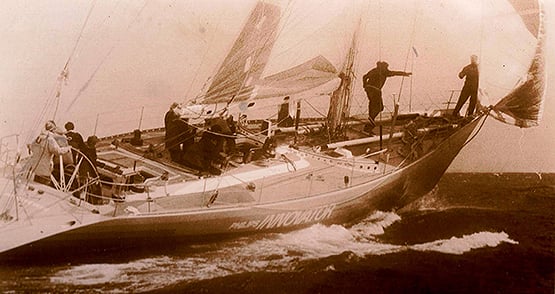
Philips Innovator battles her way around Rathlin in the 1986 Round Ireland race, with me on the grinder starboard side
That was my first experience of working a deck grinder and around Rathlin that instrument became an item to which I took a particular dislike… But that’s sailing on big boats and she was big by Irish standards then, though not now. She was a Baltic 55, built in Finland and in later years became a charter boat called Outlaw in the Caribbean. I met up with her again in Fort Lauderdale when she was named Equity & Law in the 1990-91 Round the World Race when I joined the crew of NCB Ireland in the final leg of that race across the Atlantic.
In 1992 I sailed in the Round Ireland race once again, this time aboard Mayhem out of Galway Bay Sailing Club, a 44-footer, owned and skippered by John Killeen. For her size she had a tiller and that was demanding and unusual. Particularly demanding on some heavy nights along the western coast, when one of my memories is lying in my bunk off-watch listening to the cheery voice of the Tribesmen crew as they pirouetted the boat on top of another wave and cheered loudly as the yacht took off under spinnaker.
I was to do the race, which has many happy sailing memories for me, one more time but after that my involvement was reporting it, with memories of chasing the fleet in a Wicklow Club boat from the start line, rushing back with pictures and then driving back to Donnybrook to edit the pictures at Montrose and get them onto TV News. In later years the arrival of satellite vans made life much easier.
I have memories of seeing beautiful sunrises around the top of Ireland, magnificent sunsets, conditions which varied from flat seas to pounding waves and worried nights in darkness trying to keep clear of the coastline as lighthouses winked their warnings and huge waves and high winds tried to push us ever inwards where we feared becoming ‘bayed’ and fought for open water.
There were great names and people to interview – Michael Jones who started Wicklow Sailing Club’s great idea to hold the race; Dennis Noonan who sat in his eyrie, the Race Office built alongside the club house and, with an easy grace, controlled matters. The relief of getting ashore at the end of the race to the hospitality in the club, contrasted with the always-present even if never-admitted, bit of pre-race nerves before the start.
Interviewing people like the legendary Denis Doyle on Moonduster of the RCYC, only achieved after lots of persuasive effort and hearing his wife Mary tell him how soon she expected this legendary boat and then race speed record holder to be back in Wicklow and how many days she had provisioned the yacht for. One of her comments gave me the title for one of my television race documentaries, when she said that the crew would be using the Fray Bentos tins of steak and kidney pie if they were not back in four days. I called the documentary – Four Days or the Iron Rations – and Mary laughed about that.
There were yachts with names that stood out – Commanche Raider sailed by Norbert and Patrick Reilly, Jim Donegan’s White Rooster from Cork; the maxi Drum, named Mazda Drum for the race and other international boat names – Rothmans, Creighton’s naturally and Colm Barrington with the W60 named Jeep Cherokee which set a record of 76 hours 23 minutes and 57 seconds making the story of the race in 1998.
I broadcast radio programmes from the club house on the eve of the race start, sat on the rooftop lounge drinking nightcaps with club members and harbour staff and once was given the honour of doing the public address race start commentary. Great memories and so many other names and personalities flooded through my mind when Peter Shearer, the current Chairman of Wicklow’s Race Committee announced that next year, for the first time, there will be a separate multihull class.
That, I thought, is an example of how Wicklow has retained its dominance of the race, despite several attempts over the years by bigger clubs to wrest it to their locale.
It will add a new international dimension and should bring more excitement to the event which is a staple of the Irish offshore scene. Over the years they have established links with the Royal Ocean Racing Club and next June will host it jointly, as they did two years ago, with the Royal Irish Yacht Club of Dun Laoghaire. Spreading their wings and involving more people rather than maintaining an exclusive solo run, so that the race continues to be a Wicklow event is important so that clubs in locations that are not major centres, show what they can contribute to the sport.
There will be a new trophy for the multihulls and another new one for the best sailing school boat, as the race is popular with sailing schools.
Already Team Concise has pledged its three multihulls and Rambler 88 from the US, a sophisticated racing machine is committed to take part.
For me it is a long way from Philips Innovator and Mayhem, but it is the evolution of a special, iconic Irish race.
If you haven’t done it, try it.
The start line on the eighteenth of June at 2pm for the 19th running of the race should be a great place.
Round Ireland Yacht Race 2016 – Notice of Race Issued
#roundsireland – The 2016 Round Ireland Yacht Race is scheduled to start from Wicklow Bay at 14:00 hrs on Saturday 18th June 2016 and organisers are seeking early interest.
The Round Ireland is a biennial 704 mile circumnavigation of the island of Ireland, starting and finishing in Wicklow. The 2016 race will be the 19th of the series, with the first race having been sailed in 1980.
The race is organised by Wicklow Sailing Club, in association with the Royal Ocean Racing Club and the Royal Irish Yacht Club in Dun Laoghaire.
The race provides spectacular scenery around the coastline of Ireland. There is a series of challenging tidal gates and varying sea conditions. Finally, there is the massive welcome home at Wicklow Sailing Club.
The Preliminary Notice of Race is attached; enquiries have already been received at the race office from interested boat owners.
The Royal Ocean Racing Club has confirmed that the race will continue to merit bonus points (1.4) for participants and the Royal Irish Yacht Club will once again provide a base for those boats who wish to use Dun Laoghaire as a base.
In 2014, the overall winner was Tanit (Richard Harris and team from Glasgow), while line honours went to Monster Project (Andy Budgen and local WSC sailor David Ryan). The overall record of 2 days 17 hours 48 minutes 47 seconds is held by Mike Slade in ICAP Leopard 3 achieved in 2008.
The race officially opens for entries in January 2016 but seek early enquiries. Download the preliminary NOR below.
Coastal Rowers Take on the Whole of Ireland
A team of 20 rowers have been circumnavigating the island of Ireland in a small, self-built skiff to raise funds for Cystic Fibrosis Ireland (CFI). Their plan for today (Thursday) is row up the Co Down coast to Blackhead, and then on to Portavogie.
The rowers, of mixed ability and experience, set off from Bray, Co. Wicklow on May 30th with crews of two oarsmen/women at a time rowing in relays. The rowers have planned stops at 50 designated points along the coast, with support on hand from a shore-based crew as well as cover boats that will escort the boat on some of the more challenging legs.
The team is particularly thankful for the support of local people, and some rowers can join the crew along the way.
‘Row-A-Round Ireland’ is the brainchild of Bray-based maritime enthusiast Ger Crowley, who said the trip was a huge challenge for all involved.
“It’s an ambitious project, a journey of almost 1,000 nautical miles, and the main objective is to safely row an open 15ft timber skiff around the island,” Crowley said. “Each two-person crew will contribute 100 miles towards the overall voyage over a period of a week or so, rowing on average up to 20 miles per day, so it’s a big ask for all our volunteers.
“The other objective, of course, is to raise funds and awareness for Cystic Fibrosis Ireland and all our rowers are giving their time and effort for free,” he says.
The Row-A-Round Ireland crew is drawn mainly from the immediate Crowley family and friends, under the watchful eye of team mascot and coxswain Joey the labrador. A true sea dog, Joey has a regular spot in the stern of the boat as it makes its way up and down the Bray coast on training rows. Although the journey will consist of 50 one-day legs, the changeable Irish weather means the crew has allowed 120 days to complete the challenge safely.
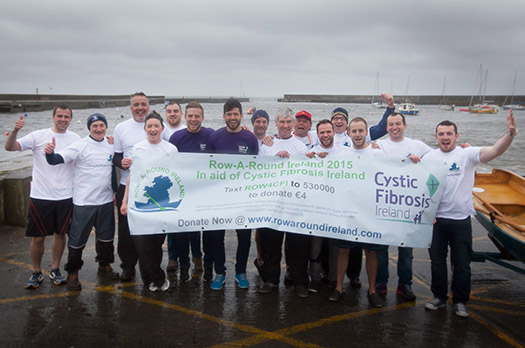
“Weather is going to be an issue alright, and there are some treacherous stretches of water to be navigated including Donegal Bay which comprises some 30 miles of the open Atlantic Ocean, Clew Bay, the Cliffs of Moher and from Loop Head across the mouth of the mighty Shannon,” says Ger Crowley, who built the boat.
The challenge also involves shore-based logistical support with a vehicle following the crew on land bringing change-over crews to intended landing areas, spares for repairs, food and also serving as a retrieval vehicle here beach landings are involved.
The team is also counting on local community support along the way, with many members of the maritime community including rowing, sailing and diving clubs around the country having pledged their support by offering food, accommodation as well as valuable advice and local knowledge.
Funds will be raised as the boat makes its way around Ireland, with all money going towards fighting Cystic Fibrosis, a fatal genetic disease that affects approximately 1 in 1600 births in Ireland, the country with the highest incidence of CF in the developed world.



























